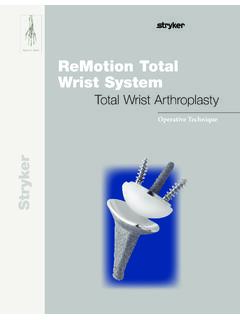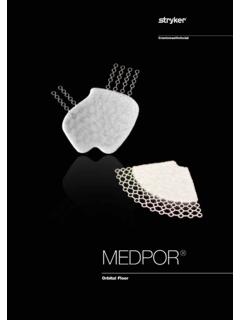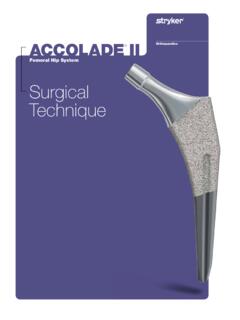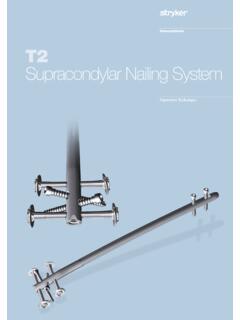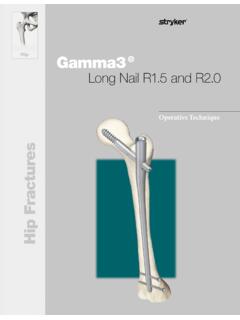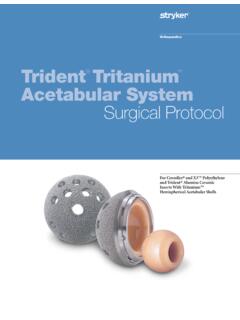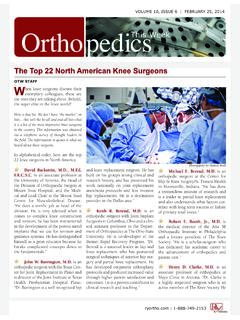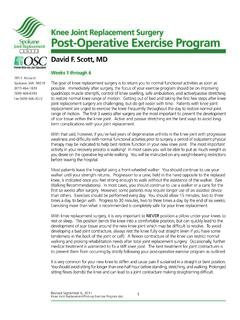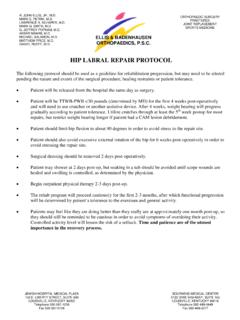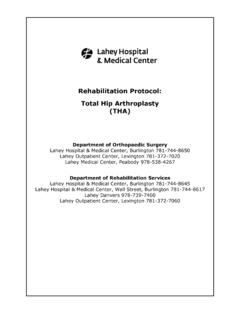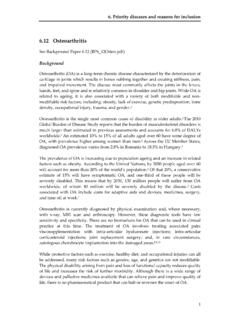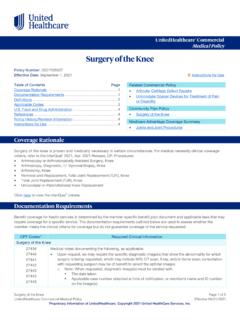Transcription of 210469 TKA Robotic Surgical Technique
1 SurgicalGuideMako TKA Surgical GuideiiiTABLE OF 1 SYSTEM OVERVIEW .. 3A. MAKO TKA SYSTEM .. 3B. TKA IMPLANT 4 INDICATIONS FOR USE .. 4 PATIENT SELECTION .. 4 MAKO TKA 5A. CT SCAN .. 5B. INSTRUMENTATION .. 5C. MAKO TKA TERMINOLOGY .. 5D. SURGEON PREFERENCES .. 6 PRE-OPERATIVE 7A. CT LANDMARKS REVIEW ..7B. RESECTION LANDMARKS REVIEW .. 8C. IMPLANT PLANNING (PRE-OPERATIVE) .. 8 MAKO TKA Surgical Technique .. 17A. PATIENT POSITIONING .. 17B. MAKO SYSTEM SETUP ..17C. EXPOSURE .. 22D. BONE ARRAY PLACEMENT .. 24E. BONE REGISTRATION .. 27F. INTRA-OPERATIVE PLANNING .. 30G. RIO SETUP - OPTIMIZE 42H. BONE PREPARATION .. 44I. TRIAL REDUCTION AND JOINT 53J. POST-RESECTION IMPLANT ADJUSTMENTS .. 54K. FINAL COMPONENT PREPARATION .. 55L. PATELLAR PREPARATION .. 55M. FINAL COMPONENT IMPLANTATION .. 55N. CASE COMPLETION .. 56 Mako TKA Surgical GuideivMako TKA Surgical Guide1 INTRODUCTIONUser Manual Terms of UseThis manual is provided by MAKO Surgical Corp.
2 (Stryker) and may be used for informational purposes only. Terms and Conditions related to the use of the Stryker Robotic Arm System (Mako) can be found in the placement agreement with the system This ManualThis manual describes the Mako Total knee Arthroplasty (TKA) Surgical Technique assisted by the Stryker Robotic Arm System (Mako). The procedure will be identified as Mako (MAKO plasty) TKA in this Support/FeedbackMAKO Surgical Corp. 2555 Davie Rd. Ft. Lauderdale, FL 33317 USAC ustomer Service +1 (855) 303-6256 and Product InformationThis manual is informational only and is not intended as medical advice or a substitute for medical advice. As the manufacturer of medical devices in the field of orthopedics, Stryker does not practice medicine and does not recommend the Surgical techniques referenced or discussed in this manual or any other Surgical techniques for use on a particular patient. Stryker is not responsible for selection of the appropriate Surgical Technique to be utilized for an individual : Patents for UseThe Stryker Robotic Arm System (Mako) is intended to assist the surgeon in providing software defined spatial boundaries for orientation and reference information to anatomical structures during orthopedic Mako is indicated for use in Surgical knee procedures in which the use of stereotactic surgery may be appropriate, and where reference to rigid anatomical bony structures can be identified relative to a CT based model of the anatomy.
3 These procedures include: Total knee Arthroplasty (TKA).The implant systems compatible with this system: Triathlon Total knee System (CR/CS/PS Cemented Primary) KINETIS Total knee System (CR/UC).Copyrights and TrademarksThe content of this manual is protected under applicable copyright and trademark laws. You agree that you will not copy, distribute, republish, display, post, transmit or modify any content in this manual without Stryker s prior permission. Any images displayed in this manual are the property of their respective copyright owners. Any reproduction, replication, modification or distribution of any art images in this manual is prohibited. The third-party trademarks in this manual are proprietary to their respective owners. These companies or their agents have granted Stryker the right to use their TKA Surgical Guide2 Governing LawAny legal action or proceeding related to this manual or the information contained in it shall be brought exclusively in a court in Bergen County, New Jersey, and shall be governed by the laws of the State of New Jersey, without regard to conflicts of laws Version TKA are no user serviceable parts in the Mako System, refer to your Stryker authorized personnel for TKA Surgical Guide3 SYSTEM OVERVIEWA.
4 MAKO TKA SYSTEMThe Mako TKA System is used to consistently and reproducibly plan and execute a primary Total knee Arthroplasty (TKA). Using patient specific information from a pre-operative CT scan, the surgeon has the ability to pre-operatively and intra-operatively adjust the plan to achieve proper biomechanical reconstruction of the knee for patients who satisfy the criteria for indications for Mako TKA System is comprised of the following components: The Mako System Robotic Arm Camera Stand Guidance Module Mako (MAKO plasty) TKA Application software Mako knee Instrumentation Mako knee Array/Balancing Kit Mako Power System and Attachment Kit (Cutting System) Leg Positioner Kit Sterile DisposablesFigure 1. Mako TKA SystemMako TKA Surgical Guide4B. TKA IMPLANT SYSTEMSThe Mako TKA System is used to plan and execute Triathlon and KINETIS implant systems. For detailed implant information for the selected implant, refer to the appropriate Instructions for Use and Surgical Technique of the selected implant system.
5 Triathlon Instructions for Use (PN QIN 4376) Mako TKA with Triathlon Surgical Protocol (PN TRIATH-SP-21) KINETIS Instructions for Use (PN PI-004) Mako TKA with KINETIS Surgical Technique (PN 210468).INDICATIONS FOR USEFor indications and contraindications for the selected implant system, please reference the implant specific Instructions for Use. Triathlon Instructions for Use (PN QIN 4376) KINETIS Instructions for Use (PN PI-004).Familiarity with and attention to appropriate Surgical Technique for total knee replacement is essential for success of the procedure. Only surgeons who have reviewed the literature regarding total knee replacement surgery and have had training in the Technique using the Mako should perform this additional details relating to Warnings and Precautions, Possible Adverse Effects and Packaging/Sterilization (if applicable), refer to the Instructions for Use of the selected implant system. Triathlon Instructions for Use (PN QIN 4376) KINETIS Instructions for Use (PN PI-004).
6 PATIENT SELECTIONP atient selection for Mako TKA depends on the judgment of the surgeon with regard to the requirements of the patient. Prior to Mako TKA, the surgeon should consider the following: Articulation of the hip joint is necessary to complete bone registration. Metal in the operative or non-operative leg can lead to the creation of accuracy reducing artifacts in the CT scan which can adversely affect the operative plan. The presence of infection (including history of infection), acute or chronic, local or systemic should be ruled out. Poor bone quality may affect the stability of the implant. Patient size may complicate the resection procedure. Body Mass Index should be considered. Poor integrity and/or lack of ligament structures may prevent the restoration of a stable joint. The type and significance of the deformity (hyperextension, flexion contracture, or fixed varus/valgus) must be surgeon has final decision authority in choosing patients for the Mako TKA procedure.
7 The effectiveness of all knee implants can be reduced by poor patient TKA Surgical Guide5 MAKO TKA IMPLEMENTATIONA. CT SCANEach patient requires a pre-operative CT scan for the Mako TKA procedure. This scan must follow the protocol in the Mako knee CT Scanning Protocol (PN 200004).B. INSTRUMENTATIONThe Mako TKA Instrumentation and Disposables: Mako knee Instrumentation Mako knee Array/Balancing Kit Mako Power System and Attachment Kit Leg Positioner Kit Sterile Disposables: Mako Drape Kit Leg Positioner Disposable Kit Silicone Retractor Cords VIZADISC knee Procedure Tracking Kit Checkpoints Bone Pins MICS Saw Blades (Standard or Narrow) Implant System Instrumentation For specific implant system instrumentation required, refer to the Instructions for Use and Surgical Technique of the selected implant system. Mako TKA with Triathlon Surgical Protocol (PN TRIATH-SP-21) Manual TKA Surgical Technique for KINETIS (PN 210468).C. MAKO TKA TERMINOLOGY Approach ZoneA volume in space around the knee joint where surgeon enabled motorized alignment to the stereotactic boundary cutting plane is permitted when the MICS Handpiece trigger is depressed.
8 Approach ModeApproach Mode assists the user in guiding the cutting system to the stereotactic boundary for bone resection. Bone RegistrationThe process of collecting points on the bony anatomy to enable the system to track patient anatomy in real-time. CheckpointBone: A metal divot inserted into the femur or tibia to confirm that the respective bone array has not shifted since bone tool: A feature in the saw blade to confirm that the Robotic Arm Base Array has not shifted since RIO Registration. Cutting ModeCutting Mode enables power to the cutting system while constraining the cutting system to the stereotactic boundary for bone resection. Engage LineThe Engage Line is where the MICS Handpiece cutting tool is moved to during surgeon enabled motorized alignment. It is a mediolateral line segment located approximately 20 mm from the TKA Surgical Guide6 Free ModeFree Mode (Unlock) disables Approach Mode and Cutting Mode. If pressed while in Cutting Mode, power to the MICS Handpiece is disabled and then the stereotactic control is disabled.
9 MICS: MAKO Integrated Cutting SystemThe MAKO Integrated Cutting System consists of a MICS Handpiece, Right Angle Saw Attachment, Sagittal Saw Attachment, Standard Saw Blade, and Narrow Saw Blade. MPS: Mako Product SpecialistThe Mako Product Specialist, or the Stryker Representative helps operate the Mako (MAKO plasty) TKA Application software during the Surgical procedure. PCAP osterior Condylar Axis is defined by a line connecting the two most posterior points of the medial and lateral condyles. Mako CenterlineThe mid-plane that bisects the Robotic Arm base into symmetrical halves (parallel to the long side panels on either side of the Mako). Stereotactic RecoveryStereotactic Recovery re-engages stereotactic control if it has been disabled while cutting. TEAT ransepicondylar Axis is defined by a line connecting the Surgical medial and lateral epicondyles. Whiteside s LineAnterior-posterior axis of the femur as defined by a line through the deepest groove of the trochlea.
10 Velocity LimitWhile in Cutting Mode, if an array moves ( , array is loose or patient leg moves) with excessive velocity, power is shut off to the cutting system, an audio warning is sounded, and stereotactic control is disabled until the leg stabilizes. VIZADISCR eflective markers that attach to the tracking arrays, allowing the camera to track their location in SURGEON PREFERENCESThe surgeon can customize the Mako (MAKO plasty) TKA Application in Surgeon Preferences. The preferences listed below are important in selecting the desired workflow: Measured Resection or Ligament Balancing workflow. Measured Resection workflow utilizes resection depths to finalize the implant plan, whereas Ligament Balancing workflow utilizes gap balancing to finalize the implant plan. Distal/Tibia Cut First or Pre-Resection Balancing . If Ligament Balancing workflow is selected, Distal/Tibia Cut First enables bone resection to set the extension gap before balancing the flexion gap, whereas Pre-Resection Balancing allows the surgeon to balance gaps before any bone resections are made.

